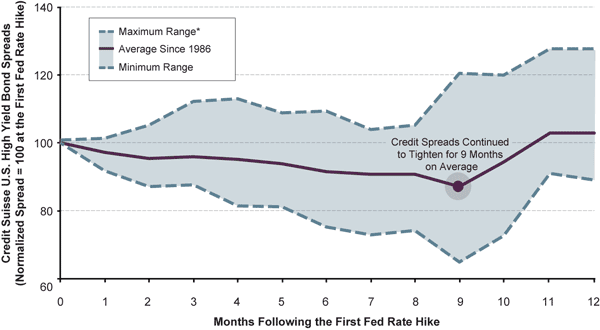When Will the Music Stop?
The investment environment is in transition, with uncertainty around policy moves contributing an increasing amount of uncertainty for asset prices.
by Scott Minerd, CIO, Guggenheim Partners, LLC
"We are not at risk of seeing an immediate correction in asset prices, but we are moving into a transition period that will be characterized by greater uncertainty around policy moves. As credit spreads continue to tighten, the market will eventually anticipate a move by the Federal Reserve to normalize interest rates. Intuitively, rising interest rates should lead to widening credit spreads, but historically that has not been the case. Instead, the past several times that the Fed has ended accommodation it has been interpreted as positive for markets. This was because the Fed would only cease accommodative policies when its members believed that economic growth would continue to accelerate. Given the historical precedents, investors should recognize that a normalization of monetary policy is unlikely to immediately cause spreads to widen."
Economic Data Releases
U.S. GDP Revised to Positive Territory, Most Other Indicators Encouraging
- GDP growth in the fourth quarter was revised up from -0.1% to 0.1%, with net exports’ contribution to GDP revised to positive.
- Durable goods orders in January fell 5.2%, but were up 1.9% excluding volatile transportation orders.
- Pending home sales climbed 4.5% in January to the highest level since April 2010.
- Jobless claims fell more than expected to 344,000. Continuing claims dropped to the lowest level since June 2008.
- Personal income dropped 3.6% in January after the 2.6% growth in December last year, due to distortions caused by the concerns over the Fiscal Cliff.
- University of Michigan consumer confidence rose more than expected in February to 77.6, increasing for a second month.
- The ISM Manufacturing PMI showed manufacturing expanded at the fastest pace since June 2011 in February with a 54.2 reading.
- The Non-Manufacturing PMI showed faster expansion in February at 56.0, the best reading in one year.
Confidence in Eurozone up, as Italian Election Effect Yet to Hit, China’s Expansion Slows Slightly
- Eurozone economic confidence increased to its highest level since May 2012, reaching 91.1 in February.
- Eurozone retail sales rose 1.2% in January, the biggest one-month gain since last May.
- Unemployment across the eurozone ticked up to 11.9% in January, the highest level on record.
- Consumer confidence in Germany rose for a third straight month in the March GfK survey.
- German retail sales increased much more than expected in January, rising by 3.1%, the most in five years.
- Italy’s Manufacturing PMI fell to 45.8 in February, after increasing the previous two months.
- The Manufacturing PMI in the U.K. unexpectedly fell to the contraction area in February at 47.9.
- Industrial production in Japan rose for the second consecutive month, with a 1.0% gain in January.
- The Manufacturing PMI in China expanded at a slower-than-expected pace of 50.1 in February, a five-month low.
- China’s Non-Manufacturing PMI was 54.5 in February, indicating a slower pace of expansion, after four months of accelerating growth.
Chart of the Week
Credit Spreads Typically Tighten After Fed Ends Accommodative Policy
A normalization of monetary accommodation does not necessarily lead to an imminent widening in credit spreads. Since 1986, the Federal Reserve started to unwind its easing policies five times, during four of which, U.S. high yield spreads continued to ratchet in. On average, credit spreads kept tightening for nine months following the first increase in the Federal Funds Target Rate, as the strengthening economy tended to remain supportive of risk assets.
U.S. HIGH YIELD BOND SPREAD PERFORMANCE WHEN THE FED STARTED RAISING RATES

Source: Credit Suisse, Bloomberg, Guggenheim Investments. Data as of 2/28/2013. *Note: The range is generated by calculating the max/min value for all five previous cycles.
This article is distributed for informational purposes only and should not be considered as investing advice or a recommendation of any particular security, strategy or investment product. This article contains opinions of the author but not necessarily those of Guggenheim Partners or its subsidiaries. The author’s opinions are subject to change without notice. Forward looking statements, estimates, and certain information contained herein are based upon proprietary and non-proprietary research and other sources. Information contained herein has been obtained from sources believed to be reliable, but are not assured as to accuracy. No part of this article may be reproduced in any form, or referred to in any other publication, without express written permission of Guggenheim Partners, LLC. ©2013, Guggenheim Partners. Past performance is not indicative of future results. There is neither representation nor warranty as to the current accuracy of, nor liability for, decisions based on such information.













